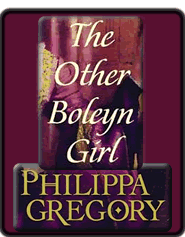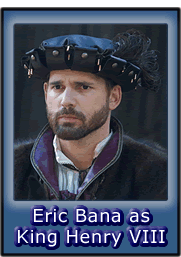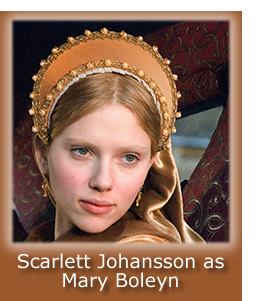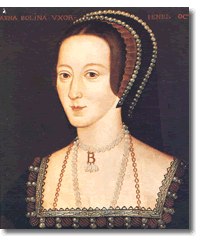From Novel to Movie to Bad History:
Another Boleyn Girl?
Although, my mistress, you have not been pleased to remember
the promise which you made me when I was last with you,
which was that I should hear good news of you and have
an answer to my last letter; yet I think it is fitting
for a true servant (since otherwise he can know nothing)
to send to inquire about his mistress's welfare;
and to acquit myself in the office of true servant,
I send you this letter, begging you
to inform me that you are prospering.
— Letter of Henry VIII to Anne Boleyn, written before July 1527.
By Ron Fritze
April 4, 2008
I went to see The Other Boleyn Girl last Saturday with Twylia. I was a little nervous. Twylia runs hot and cold on Tudor-setting movies. She did not like Shakespeare in Love, but considered the two Elizabeth movies to be "okay" — high praise by the way. At the end of the show, we emerged pleased with the story, the sets, and the acting. As for the history, I was disappointed.

Based on a novel with the same title by Phillipa Gregory, The Other Boleyn Girl
tells the story of the two sisters, Anne and Mary Boleyn. Anne the eldest is vivacious and witty, while Mary the younger is sensitive and faithful. Henry VIII rules England, but after about fifteen years of marriage, he and his wife, Katherine of Aragon, have failed to produce a male heir. Katherine's fertile days are over and Henry's eye is starting to wander to younger and more fecund pastures.
A Dubious and Unsavory Scheme.
The father of Anne and Mary, Thomas Boleyn and his brother-in-law, Thomas Howard, the duke of Norfolk, want to get a young female from their family into the king's bed as a mistress. Their candidate for this dubious honor is the regal Anne. Now if this plan seems a bit unsavory to the modern viewer, Elizabeth Boleyn, the girl's mother and Norfolk's sister, felt the same way about it. Let's face it though: Look at the way those guys are dressed! That may explain it.
The men prevail over the women's objections and the plan moves forward. Henry VIII is invited to the Boleyn estate. There Anne is dangled before him. Unfortunately for the best laid plans of men, the proud and competitive Anne creates a problem by showing off her horsemanship. She gets her horse through some rough ground, but the hapless Henry, attempting to follow, takes a bad fall from his mount. Moderately bruised in body but bruised much more in ego, he gains consciousness to find the gentle Mary nursing him.
 The king is smitten and summons Mary to court with the obvious subtext that she will be his mistress. Mary, however, is already married to William Carey. Undeterred, Thomas Boleyn and Norfolk pressure the young couple to acquiesce to the king's request.
The king is smitten and summons Mary to court with the obvious subtext that she will be his mistress. Mary, however, is already married to William Carey. Undeterred, Thomas Boleyn and Norfolk pressure the young couple to acquiesce to the king's request.
A Tryst, a Pregnancy, a Second Chance.
Once Mary arrives at court, the king summons her to his bedchamber for a tryst. The couple get along quite well, so well in fact that Mary falls in love with King Henry. As might be expected, Mary becomes pregnant, but it proves to be a rough pregnancy. She is confined to her bed, depriving Henry of her amorous attention. The king does not do depravation well. Into this volatile situation strides Anne Boleyn, looking for a second chance at bat with the king.
This time Anne plays the game of royal seduction by alternating flirting and coyness with a virtuosa's skill. She captures the king's heart with such effectiveness that Henry forgets Mary and their yet-born child. Abandoned but determined, Mary gives birth to a boy, and soon after she weds Sir William Stafford, an apparently sensitive soul, who recognizes Mary as a pearl of great price.
 A break with the Pope, divorce from Katherine of Aragon, and marriage between Henry VIII and Anne follow. But like Katherine of Aragon before her, she can't produce a male child for the impatient Henry. She does give birth to the future Queen Elizabeth I, but the potential of female heir is not good enough for Henry VIII and the English people. Anne and Henry fall out of love in the midst of rather nasty court intrigue that results in Anne's conviction for treason and her execution along with her brother George. Mary bravely pleads for her sister's life, but Henry VIII is not to be moved. At the end, the movie implies that Mary raises her orphaned niece Elizabeth, who goes on to be one of England's greatest monarchs.
A break with the Pope, divorce from Katherine of Aragon, and marriage between Henry VIII and Anne follow. But like Katherine of Aragon before her, she can't produce a male child for the impatient Henry. She does give birth to the future Queen Elizabeth I, but the potential of female heir is not good enough for Henry VIII and the English people. Anne and Henry fall out of love in the midst of rather nasty court intrigue that results in Anne's conviction for treason and her execution along with her brother George. Mary bravely pleads for her sister's life, but Henry VIII is not to be moved. At the end, the movie implies that Mary raises her orphaned niece Elizabeth, who goes on to be one of England's greatest monarchs.
A Satisfying Tale Short on History.
The Other Boleyn Girl is a nice tale of two sisters, one sweet and caring, the other overly ambitious and a bit selfish. The film flows in the same vein as any good teenagers-versus-crazed-slasher movie, proving that the good girl lives and the promiscuous girl gets punished and dies. In this case, Henry VIII is Bluebeard. Scarlett Johanssen plays Mary with sincerity and dignity, while Natalie Portman makes a stunning Anne Boleyn. Eric Bana does a good job portraying Henry VIII, although he fails to reach the true level of whininess and self-pity that characterized the historical Henry. While The Other Boleyn Girl provides a tidy and satisfying story, it is not at all reliable history.
For those who know a bit about the Tudors, watching The Other Boleyn Girl is a bit confusing. Most historians have considered Mary Boleyn to be the eldest sister and Anne to be the younger.
 The contention that Anne is actually the eldest Boleyn daughter is very much a minority opinion. Be that as it may, the birth order of the sisters is not all that integral to the plot of the movie. Unfortunately the movie plays a bit fast and loose with other facts of Mary's life.
The contention that Anne is actually the eldest Boleyn daughter is very much a minority opinion. Be that as it may, the birth order of the sisters is not all that integral to the plot of the movie. Unfortunately the movie plays a bit fast and loose with other facts of Mary's life.
Mary was born in 1499, making her about a year older than Anne. In 1514 she traveled to France as a lady-in-waiting to Mary Tudor, the younger sister of Henry VIII. Mary Tudor went to France to marry the elderly Louis XII who, conveniently for her, died early in 1515. Mary Tudor returned home, but Mary Boleyn stayed on at the France court for several more years and gained a reputation for promiscuity.
Mary Marries Carey.
Mary's father brought her back to the English court, where she married William Carey on 4 February 1520. Mary met Carey at court, not back at her parents' house as is depicted in the movie. It appears she had become the king's mistress by early 1522, with their relationship ending during the first half of 1525. Mary resumed living with William Carey, and on 4 March 1526 she gave birth to Henry Carey (1526-1596). The movie portrays Henry Carey as the illegitimate son of Henry VIII, as did hostile supporters of Katherine of Aragon, but that is not supported by any evidence.
After William Carey died on 23 June 1528, Mary came back under the care of her father. She fell from favor in 1534 when she secretly married Sir William Stafford (1512?-1556), who alternately served in the garrison of Calais and hung around the court. Note, Mary was over ten years his senior. Her pregnancy revealed the secret marriage, which didn't sit well with the family and others, who judged Stafford's social status as too low for marriage to the queen's sister. Stafford was not a member of Thomas Boleyn's household as the movie indicates.
Thomas Boleyn cut off Mary's allowance and the couple was banned from court. After the execution of Anne Boleyn, Mary reconciled with her father and lived a quiet life until her death in 1543. Henry VIII and Elizabeth I in turn looked after her children. Elizabeth gave Henry Carey the title of Lord Hunsdon and he served her well in the north of England. His son Robert Carey in 1603 rode non-stop from London to Edinburgh to bring the news of the death of Elizabeth I to her heir, James VI of Scotland. When it is all said and done, the real Mary Boleyn was not the retiring homebody as she is portrayed in The Other Boleyn Girl.
A Woman of Poise and Personality.
As for the real Anne Boleyn, she was not a great beauty like the actress Natalie Portman.
 Contemporary commentators agree consistently that she was not outstandingly attractive in a physical sense. Most, however, credit her with a poise and personality that made up for what she lacked in looks. There is no evidence that Thomas Boleyn dangled his daughters before Henry VIII in the hope of one of them becoming a royal mistress. The scene of Henry VIII visiting the Boleyn's estate is fiction, as is the scene of the king having a riding accident, although the king did fall off (or was knocked off) his horse more than once in his life.
Contemporary commentators agree consistently that she was not outstandingly attractive in a physical sense. Most, however, credit her with a poise and personality that made up for what she lacked in looks. There is no evidence that Thomas Boleyn dangled his daughters before Henry VIII in the hope of one of them becoming a royal mistress. The scene of Henry VIII visiting the Boleyn's estate is fiction, as is the scene of the king having a riding accident, although the king did fall off (or was knocked off) his horse more than once in his life.
Given the contrasts in the appearance of Johanssen and Portman, it is hard to imagine them as sisters, but that is Hollywood — and perhaps it was Hollywood that Lytton Strachey should have had in mind when he wrote: "For ignorance is the first requisite of the historian — ignorance which simplifies and clarifies, which selects and omits, with a placid perfection unattainable by the highest art."
Click on the black panther to read Ron Fritze's previous essay,
"10,000 B.C. — Wooly Mammoth Stampedes, Grateful Sabretooth Cats, Pyramid Building, and Slave Revolts: Now that's Entertainment! Or, Perhaps Not."
|

|




